Pierce County Medical Examiner
Conducted by Tacoma-Pierce County Health Department


Pierce County Medical Examiner
Conducted by Tacoma-Pierce County Health Department

We are pleased to present our Annual Report for 2022. This report reflects the work of the Pierce County Medical Examiner’s Office during the 2022 calendar year, and was produced in significant collaboration with the Tacoma-Pierce County Health Department. Only those deaths which occurred within the confines of Pierce County are included.
The Pierce County Medical Examiner’s Office prides itself on providing outstanding service to the Pierce County community.
Our commitment to excellence is evidenced by our accreditation by the National Association of Medical Examiners, which we have held continuously since 1987.

The mission of the Pierce County Medical Examiner’s (PCME) Office is to serve the living through death investigations and forensic postmortem examinations. The office seeks to identify and develop an understanding of unnatural and unlawful deaths occurring in Pierce County. Through teamwork, continuous improvement and education, compassionate death investigations and postmortem examinations, PCME seeks to serve the residents of Pierce County by providing timely, accurate and thorough services.

The Pierce County Medical Examiner’s Office operates under the authority of the laws of the State of Washington for the purpose of investigating and determining the cause and manner of death for deaths that occur in Pierce County and fall within medical examiner jurisdiction. This includes all violent or otherwise apparently unnatural deaths, and may also include apparent natural deaths that occur unexpectedly, under suspicious circumstances and/or outside of medical care, and other deaths that are thought to be of concern to public health, safety and welfare
Based on the evidence provided and discovered, PCME makes every attempt to accurately determine or confirm the identity of the deceased, to clarify the circumstances leading to death, and to accurately determine the cause and manner of death. The office employs highly trained professional, investigative, technical and administrative staff who utilize modern medical and forensic science and who work collaboratively with other public agencies. That said, the conclusions reached by the medical examiner and the work product produced are ultimately formulated independently from all other public agencies and offices.
PCME is funded by the citizens of Pierce County and operates within the structure of Pierce County government, specifically the Office of the Executive. The office is staffed with board-certified physician forensic pathologists who serve as medical examiners and who direct and supervise the activities of the office, under the leadership of the Chief Medical Examiner.

While interacting and cooperating with many federal, state, county and municipal agencies, PCME provides for an independent assessment of an individual’s death. The objective and independent role of PCME calls for sound and impartial forensic medical documentation and testimony for both criminal and civil legal proceedings. PCME’s jurisdiction is defined in two ways: geographic and statutory. PCME’s geographic jurisdiction includes the entirety of Pierce County. PCME’s statutory jurisdiction is over human remains in certain cases as defined by the Revised Code of Washington Title 68, Chapter 50, Section 010 (RCW 68.50.010). The medical examiner has statutory authority to perform autopsies without family permission, although the office strives to accommodate family wishes to the greatest extent possible within the context of performing responsible death investigations and thorough service to the greater public.
Reportable deaths to PCME include, but are not limited to, the following circumstances (adapted from RCW 68.50.010):
1. Persons who die suddenly when in apparent good health and without medical attendance.
2. Circumstances that indicate death was caused in part or entirely by unnatural or unlawful means.
3. Suspicious circumstances.
4. Unknown or obscure causes.
5. Deaths caused by an injury, whether the primary or a contributing cause.
6. Rapidly fatal contagious disease, with public health risk.
7. Unclaimed bodies.
8. Premature and stillborn infants where suspicious circumstances exist.
The medical examiner’s geographic jurisdiction includes all 1,668 square miles of Pierce County. The geographic jurisdiction extends from outlying areas in the Puget Sound, including Anderson Island and Key Peninsula, to the peak of Mt. Rainier, to southern communities, and to small rural areas in the north. The County is bordered by King County to the north, Kitsap and Thurston Counties to the west, Lewis County to the south, and Yakima and Kittitas counties to the east. In 2022, Pierce County population was estimated to be 937,400.
This report briefly summarizes all deaths that occurred in Pierce County in 2022 (including those where PCME did not assume jurisdiction) (Table 1). Information about the total number of deaths comes from the Washington State Center for Health Statistics annual death files. Due to changes in the data systems and staffing, 2021 is considered to be the baseline year for all current and future reporting. 2021 values are shown as a comparison where appropriate.
This report is divided into three main sections. The first section (Process Indicators) describes the processes and work of the Pierce County Medical Examiner’s Office. Tables 2-7 describe process indicators that measure the amount of work that PCME completes on an annual basis. The remainder of the report is limited to deaths where PCME assumed jurisdiction. The second section (Descriptive Statistics) describes the deaths included in the medical examiner’s jurisdiction. Table 7 -Table 11 outline several demographics of those who passed in the last two years. The final section (Specific Means of Death) describes specific means of deaths in greater detail. Table 12- Table 29 show demographic information for certain groups by manner of death. Table 30 - Table 45 show the overall count of decedents by mean, with demographic information for each mean of death being highlighted. The specific means of deaths reviewed are: deaths due to firearms, drug poisonings, motor vehicle accidents, weather-related events, and COVID-19. Table 46-Table 51 highlight deaths among certain populations of interest: those extremely young, those experiencing homelessness, and those who died within their own residence.
Note: The sum of the percents in the tables may not equal 100 due to rounding.
The Pierce County Medical Examiner’s Office considers each interaction with human remains to be an encounter. Multiple encounters with a single individual can occur and usually result from multiple distinct actions needing to be taken, including but not limited to, additional information becoming available that impacts the original decision made on a given case, or the need for storing of an unclaimed body. This section summarizes all encounters that the office has had over the course of the year (representing the total amount of work, not the number of individual deaths).
For more information about individual deaths, please see the section entitled “Deaths”.
In 2021, PCME conducted 3,624 encounters; this number rose to 3,687 in 2022. In 2022, more than 2000 were declined (55.9%) with 8 being consultations (Table 1).
Among all encounters, a variety of investigation types were conducted. It should be noted that among individual deaths, there can be discordant investigation types. Thus, these values indicate the volume of work by PCME rather than the individual deaths. See the section entitled “Deaths” for more information about individual deaths.
In 2021, based on the initial investigation of the scene, circumstances of death and medical history, 24 encounters involved non-human remains. This number slightly decreased in 2022 (0.7% of all encounters in 2021 compared to 0.5% in 2022).
A medicolegal death investigator typically performs a scene investigation for deaths that occur outside of a medical facility, and where there is any concern for unnatural cause of death or any question of the decedent’s identity. Across 2021 and 2022, there were approximately four times as many encounters that involved investigation of the scene where the death occurred (Decedent with Scene) compared to the number of encounters where no scene investigation was performed (Decedent no Scene).
By federal statute, jurisdiction over deaths of activeduty military personnel and their dependents that occur on a military base is maintained by military authorities, through the Armed Forces Medical Examiner System (AFMES), though these deaths are occasionally also reported to PCME As such, PCME may not be made aware of all such deaths, so the total number of encounters is likely an underestimate of the number over which the military has jurisdiction. In 2021, there were 8 (0.2% of encounters in 2021) of these, while in 2022, there were 12 (0.3% of all 2022 encounters).
PCME does not assume jurisdiction over all deaths reported, but only those deaths that, based on
Table 2 Investigation Type Among All Encounters, Pierce County Medical Examiner 2021-2022
investigation, are assessed as potentially involving anything other than solely natural causes, or when the decedent’s identity is in question. The medical examiner will also assume jurisdiction for cases where there is no other physician to certify the death, and for decedent remains that are not claimed. Based on initial investigations, 1,605 (44.3%) encounters in 2021 had ‘No Jurisdiction Assumed’ (NJA). There were approximately 125 more encounters that fit this description in 2022 compared to 2021 (1,730 encounters, 46.9% of all 2022 encounters).
A small number of encounters involved missing persons who are presumed to be dead. These deaths were termed ‘presumed deaths’. These cases generally involved persons known or believed to have gone missing in Pierce County, where there has been no evidence that they are still alive over several years since their disappearance. Information in these cases is often limited, as the body is not recovered/ examined.
In both 2021 and 2022, three encounters involved bodies that were later transferred to other counties (Table 2)
The number of unclaimed bodies remained relatively stable from 2021 to 2022 (129 and 122 respectively). For more information about these individuals, please see the section “Unclaimed Bodies” under special populations near the end of the report.
Similar to investigations, there can be discordant exam types. A more thorough exam type may be deemed necessary after an initial exam was performed, when additional information is made available. Thus, these values indicate the volume of work by PCME rather than individual deaths. See the section entitled “Pierce County Deaths” for more information about individual deaths. Table 3 lists the exam types reported by PCME. For more information about the specific types of exams, please see the Glossary.
Of the 3,624 encounters in 2021, PCME performed autopsies (partial and full) in 20.9% (n=758) of them. This number decreased slightly in 2022 to 19.6% (n=712) of all encounters. Autopsies are not performed by PCME in deaths where investigation reveals information sufficient to certify the death.
Not all cases require the same extent of investigation and examination. A full autopsy includes both a full external and internal exam, while a partial autopsy is an internal exam often limited to one specific organ, system, or body cavity, to answer a specific question or recover a foreign object in the body. In 2021, 730 encounters involved a full autopsy (20.1% of all encounters in 2021), with an additional 28 partial autopsies. 2022 had 48 fewer encounters that involved full autopsies (18.5% of all encounters in 2022), but 12 more encounters that involved partial autopsies.
In many cases, deaths can be certified via a review of relevant medical records (Records Review). These types of cases do not involve a physical examination of the body. Approximately 12.0% of all encounters in both 2021 and 2022 only required a records review.
The number of encounters involving an external examination of the body at the scene, prior to it being directly released to a funeral home (Scene External) approximately doubled from 2021 to 2022 (1.0% of all encounters in 2021 compared to 1.8% of all encounters in 2022). Meanwhile, the number of encounters involving a case in storage significantly dropped from 2021 to 2022 (15 in 2021, 1 in 2022).

The demographic makeup of individuals whose deaths are reported to PCME does not necessarily mimic the overall population of deaths. The following sections describe the demographic, individual and geographical characteristics of individuals whose deaths were reported to the medical examiner and over which PCME assumed jurisdiction.
In both 2021 and 2022, the majority of deaths that occurred in Pierce County were not reported to the medical examiner (61.3% in 2021, 61.5% in 2022). In 2021, 8,838 deaths occurred in Pierce County; only 38.8% (3,426/8,838) deaths in Pierce County were reported to PCME. In 2022, there were 8,925 deaths in Pierce County.
The percentage of deaths reported to PCME increased slightly from 2021 (38.8% to 39.1%) (Figure 1)
For various reasons (no jurisdiction assumed, transferred to other counties or to the military, non-human remains, information gathered during a death certificate review or scene investigation), PCME declined jurisdiction over 1,909 deaths in 2021 (55.7% of all deaths), and 1,997 deaths in 2022 (57.2%) (Table 4)
A small number of deaths in 2021 (8) and 2022 (3) were for missing persons presumed to be dead (‘presumed deaths’).
Throughout the report, except where stated, presumed deaths are excluded. This left 1,508 unique deaths in 2021 and 1,484 unique deaths in 2022 for analysis (Table 5).
Table 4
Deaths in Pierce County
2021- 2022
* Percent of “Total deaths referred to Pierce County Medical Examiner” out of “Total deaths in Pierce County”. Percents for “Deaths where PCME Declined Jurisdiction” and “Total PCME general cases” out of “Total deaths referred to Pierce County Medical Examiner”.
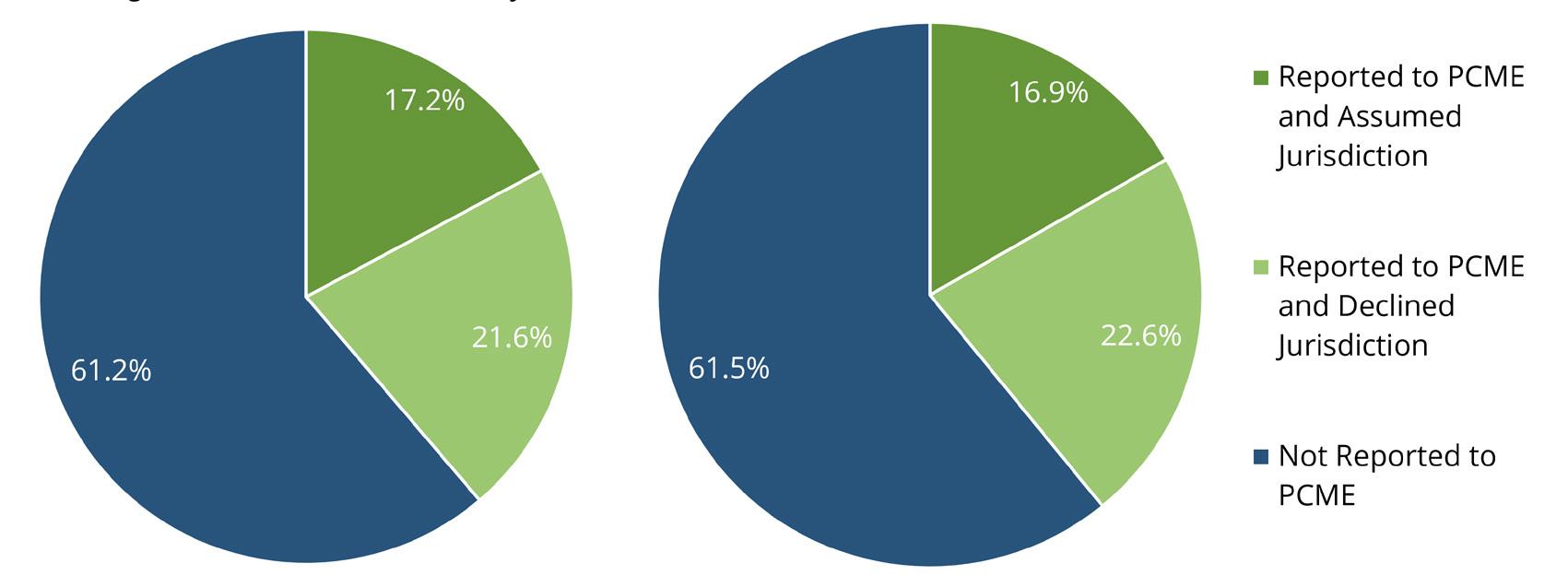
Figure 1
Percentage of Deaths in Pierce County by Reporting Status 2021- 2022
Table 5 Deaths Not Counted in Further Analysis, Pierce County Medical Examiner
2021-2022
*note that this table refers to unique deaths (not encounters).
Throughout the remainder of this report, deaths refers to those where jurisdiction was assumed, unless otherwise stated. Figure 2 shows the monthly distribution of deaths where PCME assumed jurisdiction, by the month in which the death was reported. This is not necessarily the same as the month in which the person died. While the average number of deaths reported per month remained relatively unchanged between 2021 and 2022 (approximately 287 deaths), that number was not uniform across the calendar year. Table 6 shows that January had some of the highest percentages of deaths reported to the medical examiner for both 2021 and 2022.
In both years, the percent of deaths reported to the medical examiner was lower in February than in January. In 2021, the percentage of reported deaths peaked in July, before decreasing in early fall. The same seasonal trend was not seen in 2022, as the highest percentage of deaths was seen in January and with a smaller secondary peak reported in June, and the second highest proportion seen in December (Table 6).
Figure 2

Table 6
The typical human mortality rate curve shows high mortality in the first month of life, which declines through about age 10 and then increases through the end of life, often called a J-curve. In the first year of life, infants can die due to childbirth-related complications, birth defects and infections (to name a few). 2 As an individual grows older, cells can lose their ability to function, or start functioning abnormally. As a result, older individuals are more susceptible to disease, putting them at a higher risk for death, until all individuals eventually die.
In general, the age distribution among deaths where PCME assumed jurisdiction followed the expected trend. The few exceptions were lower than expected percentages of deaths among 18-19, 35-44, and 65-74 year olds (2021), and among 18-19, 35-44, 45-54 and 65-74 year olds in 2022 (Table 7).
Table 7
Deaths by Age, where PCME Assumed Jurisdiction 2021-2022
The medical examiner reports the biological sex of the individual, which is distinct from gender identity (Table 8). The Pierce County Medical Examiner’s Office does not collect information on gender identity or on sexual orientation. Thus, throughout this report, the term “Sex” refers to “Sex at birth”. The Pierce County Medical Examiner’s Office does not collect information on the race/ethnicity of decedents, thus, they are not included in this report.
Table 8
Deaths by Sex, where PCME Assumed Jurisdiction 2021-2022
Percentage is estimated using Washington State Population Interim Estimates (PIE), December 2022. Rates may differ from previously published rates due to changes in denominators
2 UNICEF. “Neonatal mortality”. Last updated: January 2023. Accessed on September 15, 2023. Available at: https://data.unicef.org/topic/child-survival/neonatal-mortality/.
3 Percentage is estimated using Washington State Population Interim Estimates (PIE), December 2022. Rates may differ from previously published rates due to changes in denominators.

The majority of deaths where the medical examiner assumed jurisdiction and the decedent was female had an unknown pregnancy status (Table 9). The high proportion of unknowns indicates that these data should not be used to calculate maternal mortality statistics.
Table 9
Pregnancy Status Among Female Decedents, where PCME Assumed Jurisdiction 2021-2022
The location of death is not always the same as the location where the injury or incident leading to death occurred (e.g., death in a hospital following an injury sustained elsewhere). Working in collaboration with law enforcement, the Pierce County Medical Examiner’s Office makes every effort to identify both where the incident occurred and where the body was found. Throughout this report, incident and death locations are grouped into main categories. As far as PCME is aware at the time of this report, there is no publicly available general standard for how to categorize incident and death locations. See the footnotes for how locations were categorized for this report.
Most deaths in 2021 and 2022 occurred in the decedent’s residence or in the hospital. Nearly 50% more decedents were found in another person’s residence in 2021 compared to 2022 (Table 10).
Table 10
Death Location or where body was found, where PCME Assumed Jurisdiction 2021-2022
The place where a lethal incident occurred is not always the same as the location of death. Similar to the location of death, the majority of incidents leading up to an individual’s death in 2021 and 2022 occurred within the person’s own residence (56.0% in 2021, 53.6% in 2022). Along the same lines, the number of incidents leading to an individual’s death that occurred in another person’s residence substantially decreased from 2021 to 2022 (n = 74 to 57) (Table 11).
Table 11
Location of Incident Leading to Death, where PCME Assumed Jurisdiction 2021-2022
The map below shows the number of deaths in 2022 that were not classified as due to natural causes (and where the medical examiner assumed jurisdiction), by zip code. Death information for certain zip codes was unavailable due to being fully contained with federal or national lands (Figure 3)

Deaths are classified as one of six manners: Accident, Homicide, Natural, Suicide, Undetermined or Pending. The exact definitions for each of these can be found in the glossary at the end of the report. Pregnancy status by manner of death is not shown due to the lack of comprehensive information.
Deaths can also be categorized by means of death. Typical means include firearms, motor vehicles, poisonings, fires, etc.
For both 2021 and 2022, the majority of deaths where PCME assumed jurisdiction were categorized as accidents.7 Natural deaths were the second most common, with pending deaths being the least common (Table 12 ). This report does not provide a specific analysis of pending deaths as they represent a small number of deaths awaiting further information.

* Percents are out of total deaths where PCME assumed jurisdiction per year.
7 In public health reporting, accidental deaths are commonly referred to as unintentional deaths; Manner is synonymous with intent in public health data reporting.
9 Percents are out of the total for each age group. Percents may not equal 100 due to rounding.
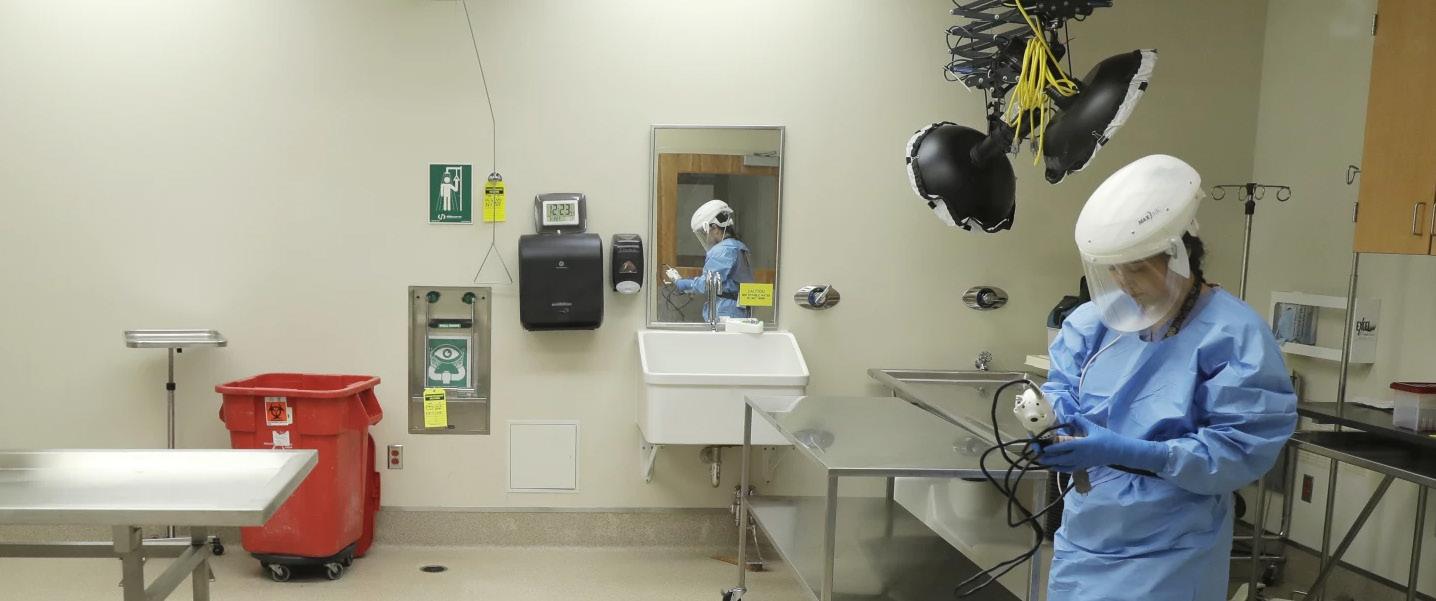
Table 14: Manner of Death by Sex, where PCME Assumed Jurisdiction 2022
There is evidence to suggest that as seasons change, so does the manner in which deaths occur. Data in some cities suggest that homicides increase in summertime. Based on 2022 Pierce County data, accidental deaths made up the largest percentage of deaths throughout the year – with it being highest in fall (65%). The highest proportion of homicide deaths was seen in winter (9%) while the highest proportion of natural deaths was seen in spring (32%) (Figure 4)

10 Winter = Jan – March, Spring = April – June, Summer = July – September, Fall = Oct – December.
Figure 4
Manner of Death by Season, where PCME Assumed Jurisdiction 2022
11 Mavroudeas, S., Papastamatelou, J., Unger, A, et al. (2019). (Summer) Time for murder: Is there a link between increased temperature and homicides? Dialogues in Clinical Neuroscience & Mental Health, 1(4). https://doi.org/https://doi. org/10.26386/obrela.v1i4.100.
An accidental death is a death due to external cause where there was no evidence of intent to cause harm.7
The medical examiner classified 831 deaths as accidents in 2021, and 802 as accidents in 2022. The largest proportion of accidental deaths was due to drugs or poisons (40.6% in 2021 and 44.8% in 2022) (Figure 5). A majority of weather-related accidental deaths occurred during the 2021 heatwave.
More information can be found in the Heat-Related Deaths section of this report.
Of all accidental deaths, the majority occurred among men (Table 16) and the majority were among those aged 75 years and older (Table 15). For both years, the majority of incidents occurred within the decedent’s own residence (53.1% in 2021, 52.1% in 2022) (Table 17)
Figure 5: Means13 of Accidental Deaths, where PCME Assumed Jurisdiction, 2021-2022
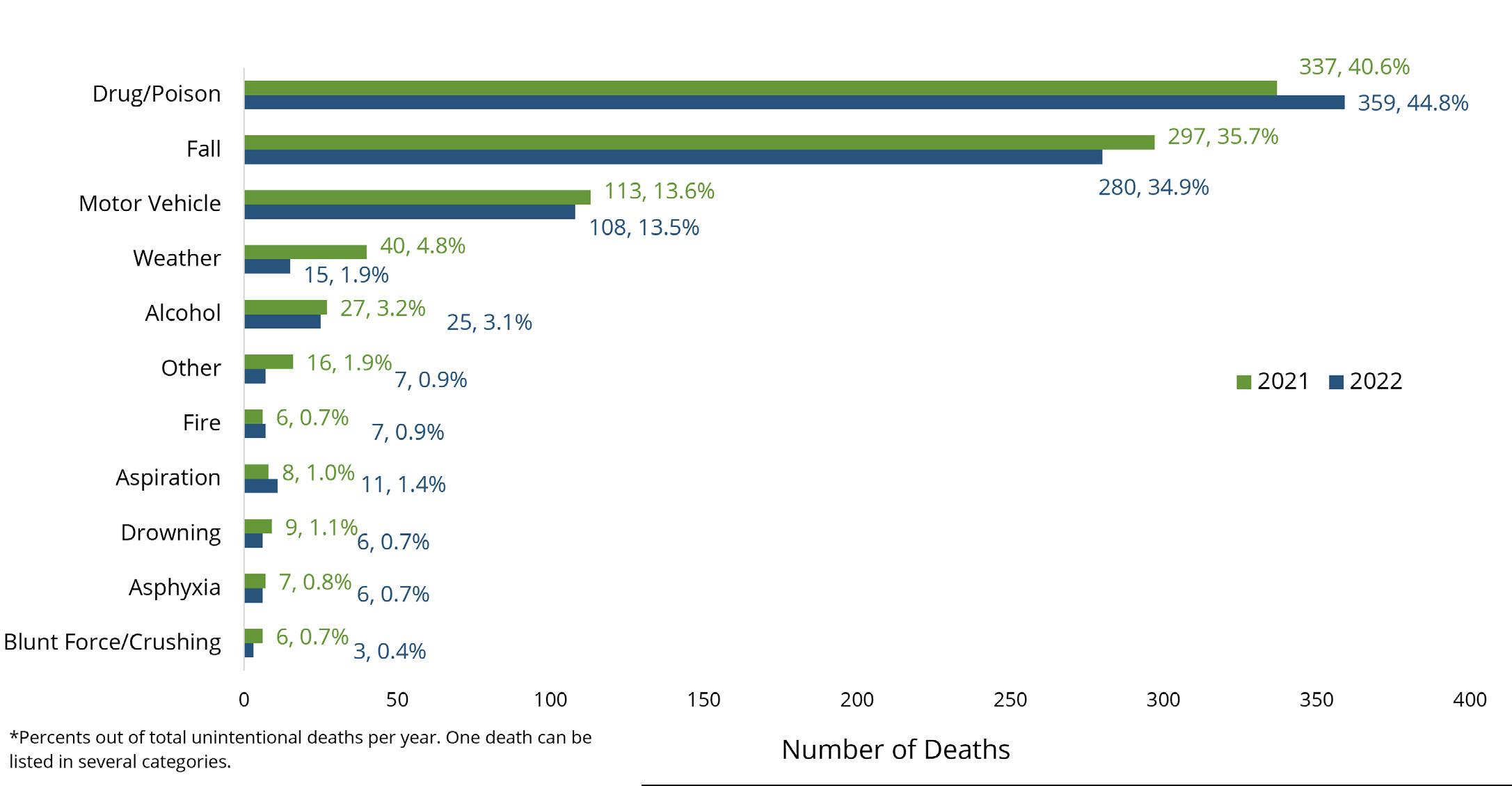
Table 15
Accidental Deaths by Age, where PCME Assumed Jurisdiction 2021-2022
13 Throughout this report, we will use the term ‘means of death’ to refer to information that lead to the death, similar to the public health classification of ICD codes into ‘mechanisms’.
Table 16
Accidental Deaths by Sex, where PCME Assumed Jurisdiction
2021-2022
Table 17
Accidental Deaths by Incident Location, where PCME Assumed Jurisdiction
2021-2022

As a manner of death, homicide is defined as “a death due to intentionally inflicted harm (explicit or implicit) of one person by another”. It is important to note that the word homicide is a legally neutral term, distinct from the criminal act of “murder”, which is defined as an unlawful homicide; as such, in deaths classified with manner homicide, prosecutors may choose to file or decline to file charges (dependent upon the findings of the criminal investigation). In 2021, the medical examiner assumed jurisdiction over 73 deaths as homicides (4.8% of deaths). In 2022, this number increased to 87 homicides (5.9% of deaths). For both years (2021 and 2022), the majority of homicides involved a firearm (n=56, 76.7% of all homicide deaths in 2021, n=77, 88.5% of all homicide deaths in 2022) (Figure 6).
Information about the type of firearm used in the homicide is collected from scene investigative reports by PCME investigators, and law enforcement reports. Limited information about the type of gun was available, but among deaths where it was known, a handgun was the most common (n=40 in 2021, n=51 in 2022) (Figure 7)
Figure 6: Means of Homicide Deaths, where PCME Assumed Jurisdiction, 2021-2022

Figure 7: Type of Firearm Used in Firearm-Related Homicides, where PCME Assumed Jurisdiction, 2021-2022

For both years, most of the deaths due to homicide were in people between 25-44 years of age (58.9% of homicide deaths in 2021, 62.0% of homicide deaths in 2022). Four homicides were in youth under the age of 18 in 2021, and five in 2022 (Table 18). Most homicides occurred in a public space/area/roadway (Table 20)
Table 18
Homicide Deaths by Age, where PCME Assumed Jurisdiction 2021-2022
Deaths due to homicide were disproportionally male (n=58, 79.5% in 2021, n=68, 78.2% in 2022) (Table 19).
Table 19
Homicide Deaths by Sex, where PCME Assumed Jurisdiction 2021-2022
Table 20
Homicide Deaths by Incident Location, where PCME Assumed Jurisdiction 2021-2022
A natural death is a death solely due to natural disease. The Pierce County medical examiner assumes jurisdiction over these deaths when there is some concern that the death did not occur naturally. This includes a sudden/ unexpected death in an otherwise healthy individual, when there is no physician or healthcare provider who has knowledge of the decedent’s medical history, or when there are suspicious circumstances surrounding the death. For these reasons, the demographic makeup of decedents who died a natural death and are reported to the Medical Examiner’s Office will not be representative of deaths among the entire Pierce County population.
The medical examiner assumed jurisdiction over 443 natural deaths in 2021, accounting for 29.4% of all deaths where PCME assumed jurisdiction for that year. In 2022, there were 42 fewer natural deaths (401, 27.0% of all deaths) where PCME assumed jurisdiction. For both years, the majority of decedents were between 45-74 years of age, and were male (Table 21) (Table 22)
Natural Deaths by Age, where PCME Assumed Jurisdiction 2021-2022
Table 22
Natural Deaths by Sex, where PCME Assumed Jurisdiction 2021-2022 Table 21
Of the natural deaths where the medical examiner assumed jurisdiction, the majority occurred within the decedent’s residence (69.8% in 2021, 72.1% in 2022). Natural deaths were less likely to occur on a public roadway, hotel or other person’s residence compared to other areas (Table 23)
Table 23
Natural Deaths by Death Location, where PCME Assumed Jurisdiction, 2021-2022
Suicides are deaths that occur as a result of a purposeful action, with intent (explicit or implicit) to harm oneself. Some examples of evidence of intent include, but are not limited to: holding a gun to one’s head and pulling the trigger, altering a car’s exhaust to suffocate, leaving a suicide note (or note of intent), or making a verbal threat of self-harm.
The medical examiner assumed jurisdiction over 132 deaths determined to be suicide in 2021 (8.7% of all deaths where jurisdiction was assumed), and 161 deaths by suicide in 2022 (10.9% of all deaths where jurisdiction was assumed). For both years, suicides were disproportionally male (76.7% in 2021, 82.6% in 2022) (Table 25).
There were 7 suicides among decedents under age 18 in 2021 (5.3%), and 8 in 2022 (5.0%) (Table 24). For both years, the most common means was use of a firearm (n=71 in 2021, n=90 in 2022). There were 64 total suicides by hanging (30 in 2021, 34 in 2022), and 28 total suicides by drug/poisons (12 in 2021, 16 in 2022) (Figure 8)
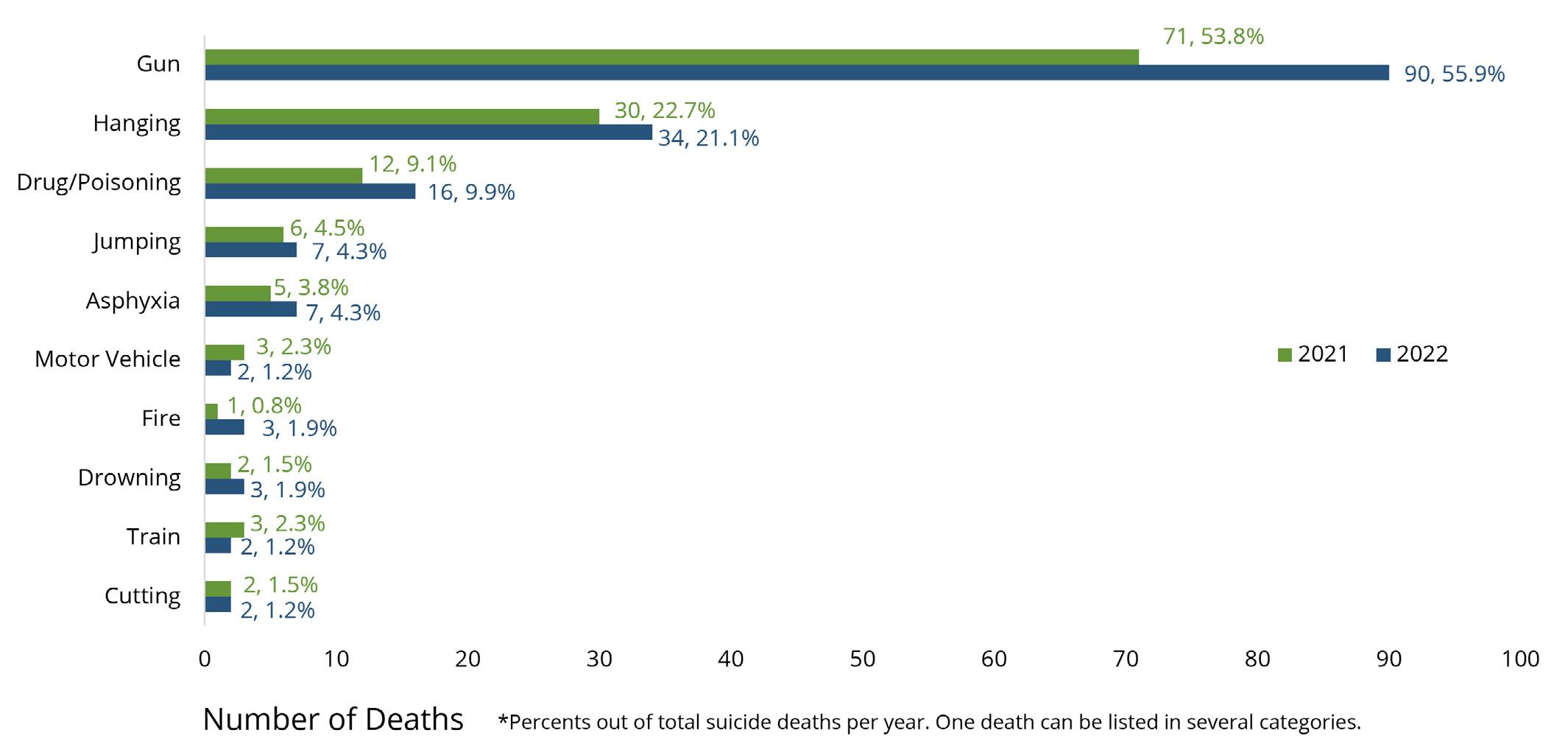
Table 24
Suicide Deaths by Age, where PCME Assumed Jurisdiction
2021-2022
Table 25
Suicide Deaths by Sex, where PCME Assumed Jurisdiction
2021-2022
Table 26
Suicide Deaths by Incident Location, where PCME Assumed Jurisdiction
2021-2022
Most suicides occurred within the individual’s own residence (65.2% in 2021, 68.9% in 2022) (Table 26).
The Washington Death with Dignity Act, Initiative 1000, codified as 70.245, passed on November 4, 2008 and took effect on March 5, 2009. This act allows terminally ill adults (who are Washington State residents) with fewer than six months to live to request lethal doses of medication from medical and osteopathic physicians. Under this law, “actions taken in accordance with this chapter do not, for any purpose, constitute suicide, assisted suicide, mercy killing or homicide, under the law”. The Pierce County Medical Examiner’s Office is not involved in these cases and collects no statistics on the number of deaths where an individual has utilized their rights under the provisions of this act. Statistics are kept and released annually by the Washington State Department of Health.
The Pierce County medical examiner certifies manner of death as undetermined when there are two or more equallycompelling options for manner of death. The Medical Examiner certified roughly 30 deaths in both 2021 and 2022 with manner undetermined (roughly 2.0% of all deaths where PCME assumed jurisdiction in both 2021 and 2022).
Of the combined 58 deaths that were classified as undetermined, drugs and poisons caused five (8.6% of all undetermined deaths). The largest group of decedents who died from an undetermined manner were under the age of one (19 in total for 2021-2022, 33.3% of all undetermined deaths), with the number more than doubling from 2021 to 2022 (6 to 13 deaths) (Table 27). Among these deaths, 17 were Sudden Unexplained Infant Deaths (manner undetermined due to the inability to exclude external factors having contributed to death).
The 58 deaths that were undetermined between 2021-2022 included one fetal death (Figure 9). Per Washington State Department of Health – Center for Health Statistics Fetal Death Certification Guidelines, this death was not assigned a manner of death. Fetal death certificates must be issued for every fetus of 20 weeks or more gestation.
Figure 9: Means of Deaths Classified as Undetermined Manner, where PCME Assumed Jurisdiction, 2021-2022

Table 27
Deaths Classified as Undetermined Manner by Age, where PCME Assumed Jurisdiction 2021-2022
Table 28
Deaths Classified as Undetermined Manner by Sex, where PCME Assumed Jurisdiction
2021-2022
Table 29
Deaths Classified as Undetermined Manner by Death Location, where PCME Assumed Jurisdiction
2021-2022
Deaths where the manner was undetermined mostly included individuals who were predominately male (Table 28). Most incidents occurred within the individual’s residence (39.3% in 2021, and 79.3% in 2022) (Table 29).
Several specific means that least to death can underly multiple different manners of death. This section of the report focuses on five different means of death; deaths due to firearms, drug poisoning, motor vehicles, COVID-19 and weather-related means. Together these account for 43.7% of the deaths where PCME assumed jurisdiction in 2022 (n=648).
The Pierce County Medical Examiner is responsible for investigating all deaths due to firearms in Pierce County. The type of firearm used and shooter characteristics are often unknown. As a result, all information (unless otherwise stated) is about the decedent.
(not including
(Heat/Cold) 20
Table 30: Selected Means of Death, where PCME Assumed Jurisdiction
The medical examiner assumed jurisdiction over 127 firearm deaths in 2021; accounting for 8.4% of all deaths where PCME had jurisdiction. Of these, the majority were classified as either suicide (53.5%) or homicide (44.1%). Three firearm deaths were classified as undetermined.
In 2022, there were 44 more firearm deaths (171 total): accounting for 11.5% of all deaths where PCME had jurisdiction. Similar to 2021, the majority were either suicides (52.6%) or homicides (45.0%). Three firearm deaths were classified as being undetermined and one was classified as an accident (Figure 10)
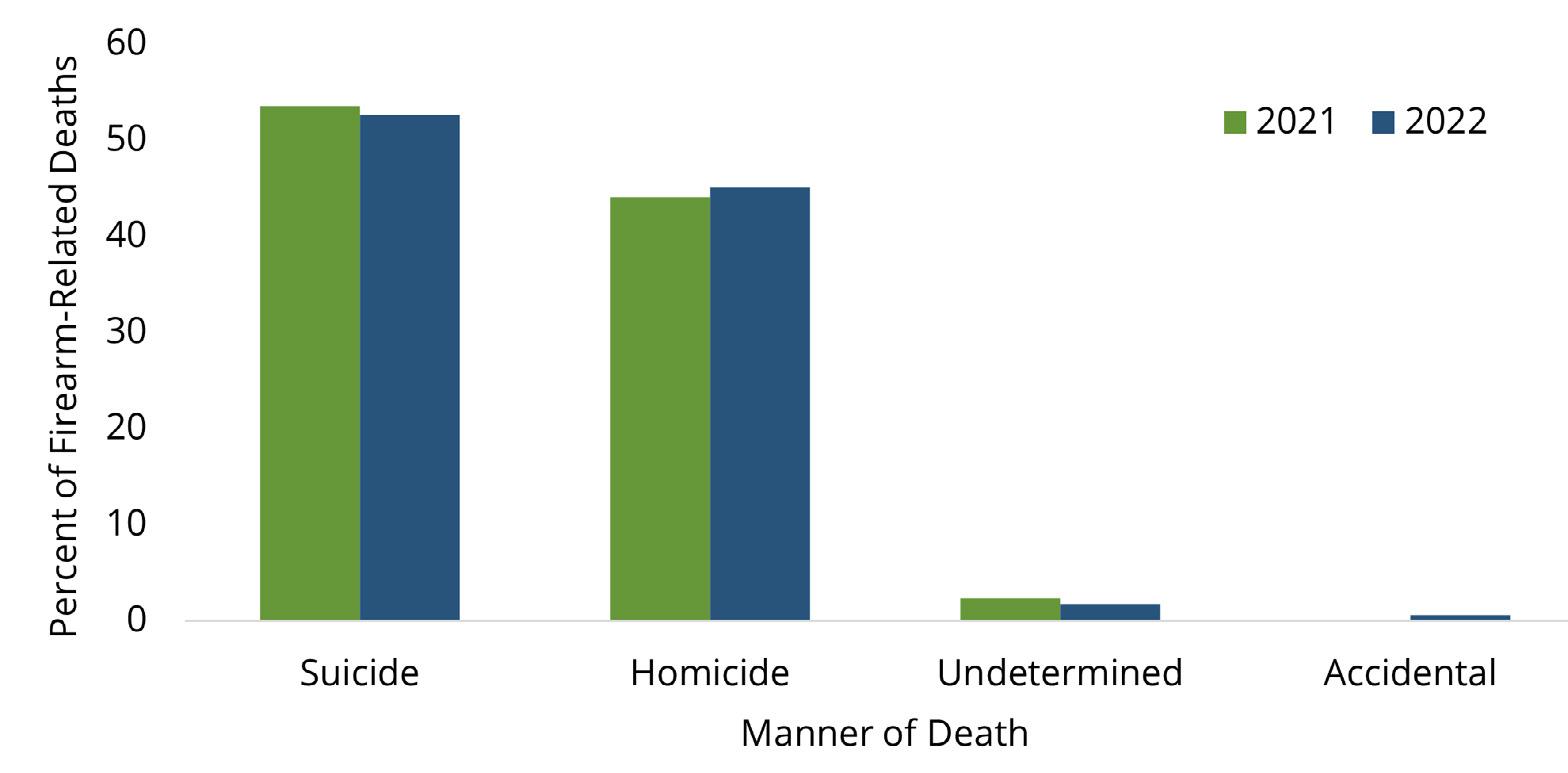
Most decedents involved in firearm-related deaths were 25-44 years of age and were disproportionally male (Table 31)
Figure 10 FirearmRelated Deaths by Manner of Death, where PCME Assumed Jurisdiction 2021-2022
Among the deaths where the type of firearm was known to PCME, the most common was a handgun (Figure 11).
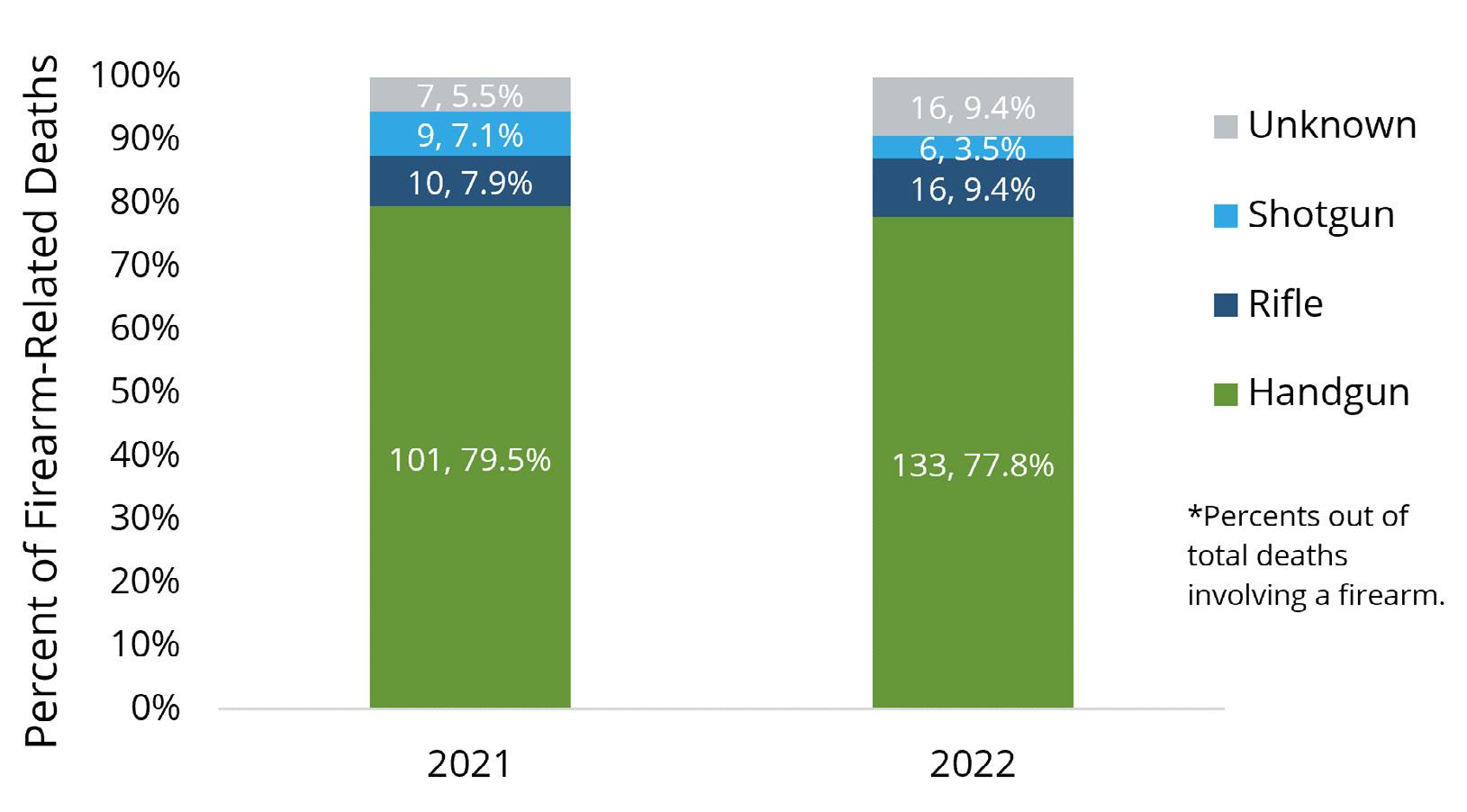
Table 31
Firearm-Related Deaths, by Manner, Age and Sex, where PCME Assumed Jurisdiction
2022
Figure 11
Type of Firearm by Percent of Firearm-Related Deaths by Year, where PCME Assumed 2021-2022
Drug overdose is a leading cause of non-natural deaths in the United States. , The Pierce County Medical Examiner distinguishes deaths due to acute drug intoxication from those caused by chronic effects of substance abuse. Deaths due solely to natural disease related to chronic substance use without acute intoxication are classified as natural deaths (e.g., deaths due to chronic alcohol use disorder) and are not included in the below tables. In particular, the number of non-natural deaths related to opioids has dramatically increased since 2009. For more information about acute drug intoxication related deaths, please see the Centers for Disease Control and Prevention’s subject page, or the Health Department’s dashboard.
Excessive alcohol use can cause acute and chronic effects, ranging from confusion, trouble breathing, cirrhosis, cancers, and death. As alcohol is frequently seen in substance-related deaths, this report outlines the total (including those with alcohol being listed as a substance having caused or contributed to death) and percentage of deaths solely due to other drugs/poisons. Deaths from the chronic effects of alcohol use are excluded as described above.
Most drug overdose deaths in 2022 were classified as accidents (Table 32) and were among those who were middle-aged (35-64 years) (Table 33). Most overdoses occurred at the individual’s own residence (Table 35), and they were disproportionally male (Table 34).
Among the 318 drug poisoning deaths that were primarily caused by substances other than alcohol, most involved opioids (over 70%), with a particularly large percentage involving fentanyl. Multiple drug categories were identified in 68.1% of the drug poisoning deaths primarily caused by substances other than alcohol. Approximately one-fifth were found to have alcohol in their system (19.5%) (Figure 12).
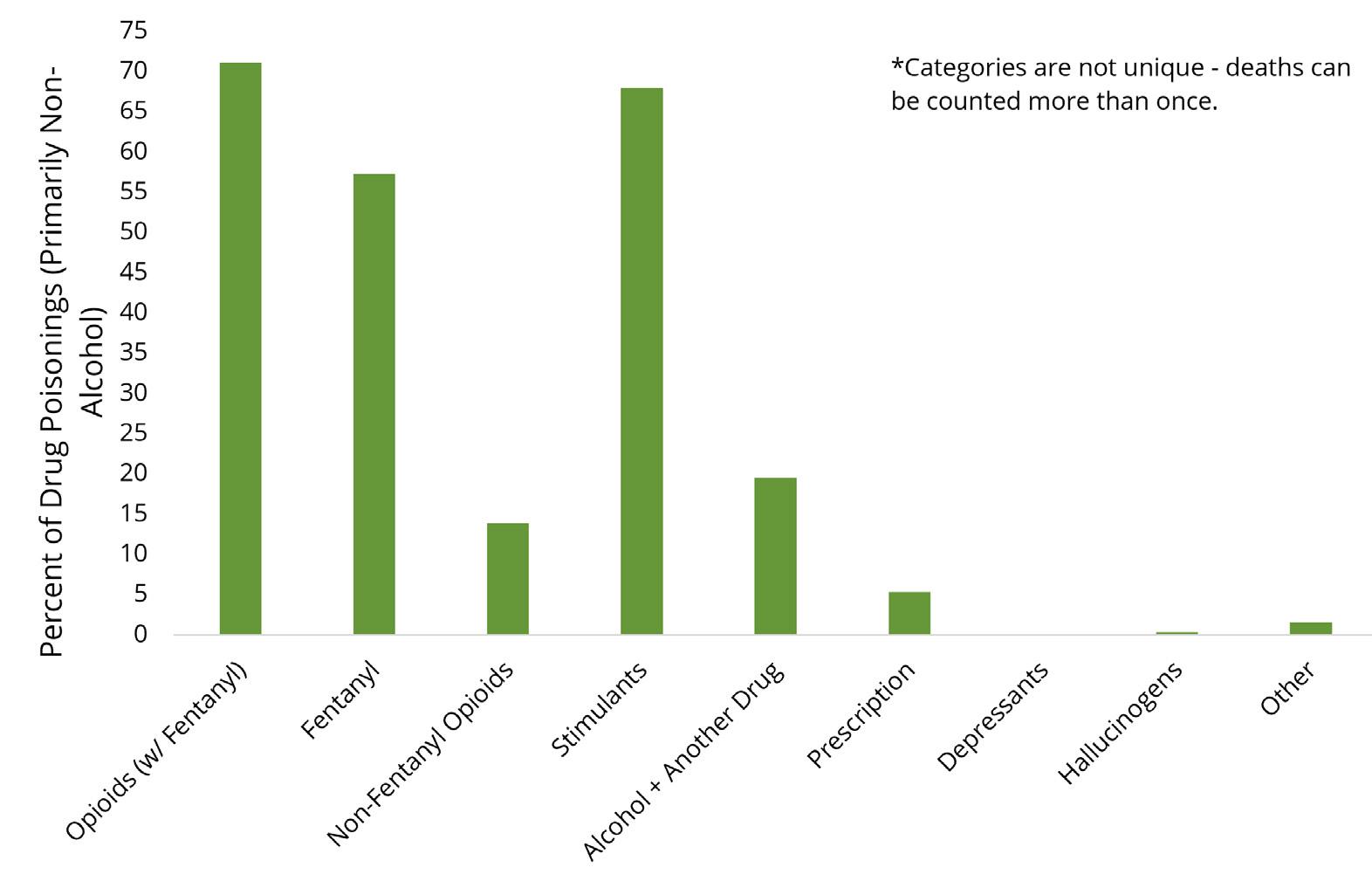
Table 34
Drug Overdose Deaths by Sex, where PCME Assumed Jurisdiction
2022
Table 35
Drug Overdose Deaths with at Least One nonAlcohol drug, by Incident Location, where PCME Assumed Jurisdiction
2022
Figure 12 Percent of Drug Poisonings (NonAlcohol) by Drug Class, where PCME Assumed Jurisdiction
2022
Motor vehicle-related deaths consist of several types: vehicle-vehicle, vehicle-pedestrian, or vehicle-object. This is a broader definition than traffic-related motor vehicle collisions alone. Although most of these deaths are accidental, it does include other manners of death, including suicide by intentional drowning in a vehicle. It excludes deaths where the primary cause was inhalation of vehicle exhaust fumes.
The medical examiner assumed jurisdiction over 121 motor vehicle related deaths in 2021, accounting for 8.0% of all deaths where PCME took jurisdiction. Of these, 113 (93.4%) were classified as accidents. Three were classified as suicides, three as homicides and two as undetermined.
In 2022, there were 9 fewer motor vehicle-related deaths (n=112), accounting for 7.5% of all deaths where PCME took jurisdiction. Similar to 2021, the majority were accidents (n=108, 96.4%). The remainder were evenly split between suicides and homicides (n=2 each).
For both 2021 and 2022, most decedents were middle-aged (25-64 years of age) (Table 36) or were male (Table 37).
Table 36
Motor VehicleRelated Deaths by Age, where PCME Assumed Jurisdiction
2021-2022
Table 37
Motor VehicleRelated Deaths by Sex, where PCME Assumed Jurisdiction
2021-2022
In 2022, the largest proportion of motor vehicle-related deaths involved incidents that occurred in the evening (between 6:00 – 11:59 PM) (Figure 13). Information about whether the decedent was wearing a safety device is largely unknown. Among the deaths where safety device usage was known, most incidents that occurred in the evening/night (6:00 PM – 5:59 AM) involved a decedent who was not wearing a seatbelt. However, the majority of decedents who died from an incident that occurred during the day (6:00 AM – 5:59 PM) (and whose safety device usage was known) were wearing a seatbelt (Figure 14) (Table 38)
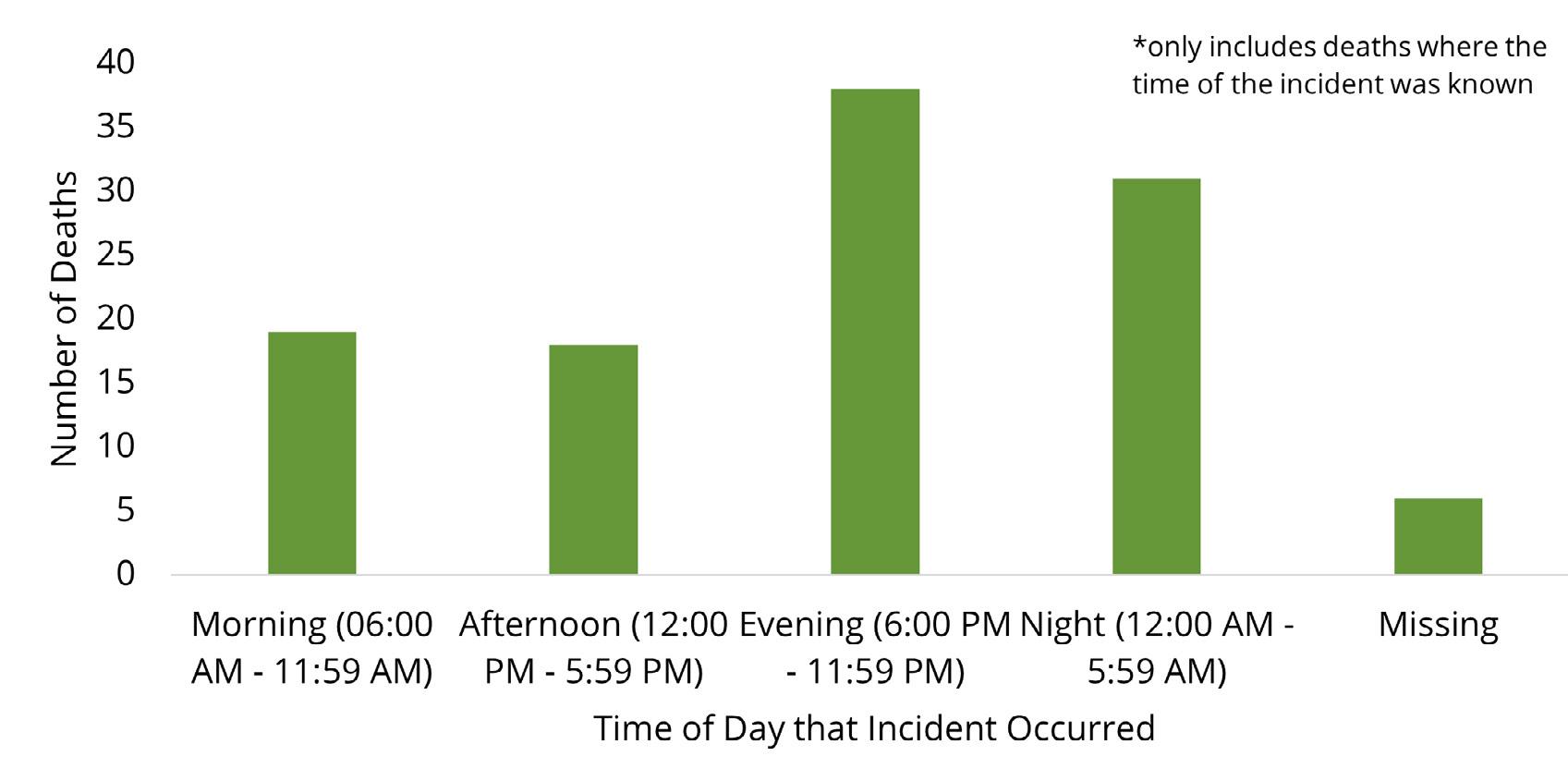

Figure 13
Motor VehicleRelated Deaths by Time of Day that Incident Occurred, where PCME Assumed Jurisdiction 2022
Figure 14
Motor VehicleRelated Deaths by Seatbelt Usage and Time of Day when Incident Occurred, where PCME Assumed Jurisdiction 2022
Table 38: Motor Vehicle-Related Deaths by Seatbelt Usage and Time of Day that Incident Occurred, where PCME Assumed Jurisdiction, 2022
Incident
The two most common types of adverse weather events that affect individuals in Pierce County are excessive heat and excessive cold. Both means of death are likely undercounted, as they often do not show up on a death certificate. Instead, it is likely that some deaths caused by excessive heat or cold were categorized as being due to cardiovascular or respiratory issues. Though environmental conditions are assessed in all cases investigated by PCME, it is often difficult to determine what impact, if any, the potentially hostile environment played in the death; as such, some deaths contributed to by hostile environment may have been certified as natural, due to the decedent’s natural disease.

The Pierce County Medical Examiner draws its definition for a heat related death from the recommendation made by the National Association of Medical Examiners Ad Hoc Committee on the Definition of Heat-Related Fatalities.
A heat-related death is a death where:
• The documented antemortem core temperature of the body was 105 F or greater.
• The body was found in an enclosed environment with high ambient temperature without an adequate cooling device.
• The individual was alive before the excessive temperatures.
There were 29 heat-related deaths in 2021 (1.9% of all deaths where the medical examiner assumed jurisdiction). The majority occurred during or shortly after the June 2021 heatwave. In 2022, the medical examiner certified two heatrelated deaths (a 93% decrease from 2021).
For both years, the majority of decedents classified as dying due to a hostile heat-related environment were 45 years or older (Table 39). No unexpected patterns were seen by sex (Table 40) and most deaths occurred in the decedent’s residence (Table 41).
Table 39: Heat-Related Deaths by Age, where PCME Assumed Jurisdiction, 2021-2022
Table 40: Heat-Related Deaths by Sex, where PCME Assumed Jurisdiction, 2021-2022
Table 41
Heat-Related Deaths by Incident Location, where PCME Assumed Jurisdiction 2021-2022
Most cold-related deaths are due to an individual’s inability to get out of a hostile cold environment. The medical examiner certified 15 deaths as being cold-related in 2021 (1.0% of all deaths over which PCME assumed jurisdiction), and 18 cold-related deaths in 2022 (1.2% of all deaths over which PCME assumed jurisdiction).
For both years, the majority of decedents in 2021 were late middle-age (55-74 years of age) and were male (Table 42)(Table 43). Unlike heat-related deaths, no clear pattern was present among cold-related deaths by location of the incident (Table 44).
Table 42
Cold-Related Deaths by Age, where PCME Assumed Jurisdiction 2022
Table 43
Cold-Related Deaths by Incident Location, where PCME Assumed Jurisdiction 2022
2021 and 2022 marked the second and third years of the COVID-19 pandemic. In 2020, many COVID-19 deaths were reported to the medical examiner as being unnatural/sudden, mainly because there was a limited understanding of the disease and how it spread. Vaccines were not available until late 2020, and measures to prevent/reduce transmission were poorly understood. In 2021, as more people became vaccinated, and the disease became better understood, fewer COVID-19 deaths were reported to the medical examiner (as it became apparent that these deaths were natural, and thus not reportable to the medical examiner). The number of deaths due to COVID-19 spiked during the 2022 omicron wave. Since then, the number of COVID-19 deaths reported to the medical examiner has continued to decrease. As a result, the number of deaths due to COVID-19 that were reported to the medical examiner is not representative of all COVID-19 deaths.
In both 2021 and 2022, most COVID-19 deaths occurred among those aged 35 years or older (Table 45).
Table 45
COVID-19 Deaths by Age, where PCME Assumed Jurisdiction
In 2021, the Pierce County medical examiner investigated 46 deaths of infants and children under 18 years of age, which was 3.1% of the total deaths where the jurisdiction was assumed. The circumstances were categorized as a combination of the manner of death and the means of death. The most common circumstances fell into a combined “other” category (26.1%). These included natural causes, congenital causes and unknown causes. The second most common cause of child deaths was motor vehicle accidents. Five deaths were certified as Sudden Unexplained Infant Death (SUID) (10.9%) with another 3 who died from suffocation.
In 2022, the medical examiner investigated 49 deaths of infants and children under 18 years of age. The most common circumstance was SUID, with 12 deaths or 24.5% of all child deaths in Pierce County that year. The second most common circumstance of death for children in 2022 was suicide (Figure 15).
Of the 95 total combined deaths among infants and children under 18 years of age in 2021-2022, 33.7% (32/95) deaths occurred among infants. Decedents were more likely to be male (n=62, 65.3%) than female (n=33, 34.7%)
Figure 15: Circumstances among Deaths under 18 years of age, where PCME Assumed Jurisdiction, 2021-2022
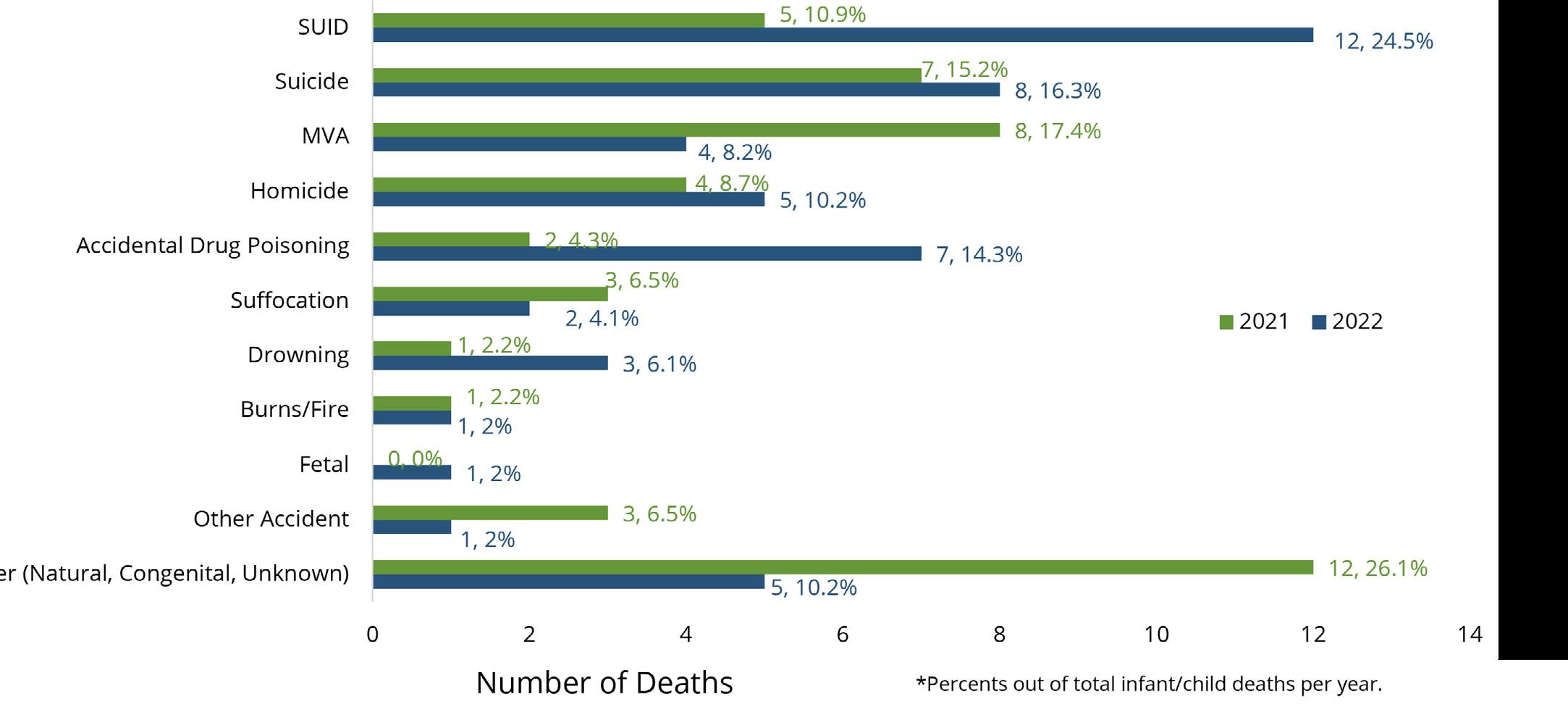
Table 46 & 47 Homicide Deaths by Age and Sex, where PCME Assumed Jurisdiction 2021-2022
The Pierce County Medical Examiner’s Office makes every effort to identify an individual’s housing status at the time of death. However, this is often unknown or incomplete – indicating that the data is underreported. Other individuals had anecdotal or circumstantial evidence regarding their housing status at the time of death – but PCME was unable to verify the information. If the anecdotal or circumstantial information indicated that the individual was experiencing homelessness at the time of death (but is not confirmed), these were classified as ‘Presumed to Have Been Experiencing Homelessness’.
There were 81 deaths (regardless of jurisdiction) among individuals experiencing homelessness in 2022, with an additional 3 deaths among individuals presumed to have been experiencing homelessness. Most deaths in Pierce County (regardless of jurisdiction) were among individuals not known to have been experiencing homelessness at the time of death (Figure 16).

Regardless of jurisdiction, most remains among deaths in individuals experiencing homelessness were claimed (indicating that someone, usually family, provided for final disposition/funeral arrangements). (Table 48).
Table 48
Unclaimed
Among the 81 deaths involving individuals experiencing homelessness in 2022, PCME assumed jurisdiction over 78 of them. Although the numbers are small, it is noteworthy that the percentage of deaths classified as homicide among individuals experiencing homelessness was approximately twice (11.5%) the percentage of deaths classified as homicide among individuals not known to be experiencing homelessness (5.6%) (Table 49).
At-home deaths, where someone dies in their own residence or the primary place where they live, usually occur without a physician present. While the number of at-home deaths has remained relatively constant over the past two years (about 700), the demographics have changed.
While the majority of deaths that occur at-home continue to be among those 55+ (approximately 54.0% for both years), 2022 saw an increase in the percentage of individuals aged 20-44 who died at home. The largest increase was seen among those aged 35-44 (11.2% of all at-home deaths in 2021: 13.9% of all at-home deaths in 2022 (increase of 25)) (Figure 17).
Figure 17: Deaths At-Home by Age, where PCME Assumed Jurisdiction, 2021-2022

The percentage of males dying at-home slightly increased from 2021 to 2022 (64.5% to 69.7%) (Table 50). Most deaths in the home in 2022 were classified as natural. It is noteworthy that the percentage of deaths classified as natural or suicide that occurred within the home was greater than the overall percentage of deaths that occurred within each manner (among all deaths where PCME assumed jurisdiction) (Table 51).
Table 50
Deaths At-Home by Sex, where PCME Assumed Jurisdiction 2021-2022
Sometimes, there is no next-of-kin or legally responsible representative known, available, or willing to claim the decedent’s body. If no one claims the body, the medical examiner assumes jurisdiction for the sole purpose of arranging for final disposition of the remains. This can happen for all reported deaths – regardless of whether the medical examiner had assumed jurisdiction for other reasons. Claim status may change at any time, as families are located and notified, or determine they are not actually able to arrange for final disposition. As such, these numbers may change and should be viewed as preliminary. There were slightly more unclaimed bodies in 2021 compared to 2022 (129 vs. 122) (Table 52).

Unclaimed and Unidentified Bodies
As one part of arranging for final disposition of unclaimed remains, the Pierce County Medical Examiner’s Office collects information about a decedent’s veteran status. Among unclaimed decedents, the majority had an unknown veteran status (approximately 65% for both years) (Table 53).
Table 52
Unclaimed and Unidentified Remains, among Deaths Reported to PCME 2021-2022
Table 53
Unclaimed Decedents by Veteran Status, among Deaths Reported to PMCE 2021-2022
Many individuals who have died have previously registered as organ/tissue donors and/or are eligible to be donors, and their family consents to their tissue being recovered. The Pierce County Medical Examiner’s Office facilitates the donation of organ/tissues for donation with organ and tissue procurement organizations whenever possible.
• Degree of variability within medical examiners for COVID related deaths
• No criteria for heat/cold related deaths
• Lack of reliable info for homeless status

Cause of Death is the etiologically specific underlying disease or injury that ultimately led to death. Specific cause of death information is recorded on the death certificate and is entered into the Washington State Vital Statistics system.
The Death Certificate is a document that specifies a person is legally deceased. It is created and issued by the Washington State Department of Health, Vital Records. For deaths that are investigated by the Medical Examiner, the Medical Examiner provides some of the information that is included on the Death Certificate (for example, the Cause and Manner of death) and signs the document. For deaths that are not investigated by the Medical Examiner, a nonMedical Examiner physician or other health care provider provides the information and signature.
Manner of Death is a statistical classification of deaths per the Washington State Department of Health into one of five pre-determined categories: Accident, Homicide, Natural, Suicide, and Undetermined (see definitions below). It should be noted that Manner of Death is assigned for Public Health statistical purposes and is NOT a legal determination.
Manner of Death: Accident
A death due to external cause without evidence of intent to harm
Manner of Death: Homicide
A death due to intentionally inflicted harm (explicit or implicit) of one person by another, including actions of grossly reckless behavior.
Manner of Death: Natural
A death solely by organic disease. If natural death is hastened by injury (such as a fall), the manner of death will not be considered natural.
Manner of Death: Pending
Pending is a temporary designation for cause and/or manner when additional investigation, information and/or test results are required for certification. Manner of death is amended once all information and test results are received and reviewed by the pathologist.
Manner of Death: Suicide
A death as the result of a purposeful action, with intent (explicit or implicit) to end one’s life.
Manner of Death: Undetermined
The manner of death assigned when there is insufficient evidence or information to assign to accident, homicide, suicide, or natural categories, or when two plausible manners are equally likely.
Poison
Any substance, taken internally or applied externally, that is injurious to health or dangerous to life.
Sex
Throughout this report the term Sex refers to the sex assigned at birth for the individual.
SUID (Sudden Unexplained Infant Death)
A death of an infant where the cause and manner are undetermined due to the inability to exclude if external factors contributed to death.
Type of Exam: Full Autopsy
External and full internal examination, often including toxicology testing, microscopic histologic examination, and various other ancillary tests
Type of Exam: Partial Autopsy
External examination and partial internal examination; anything that requires an incision.
Type of Exam: Bones
Examination of bone specimen(s).
Type of Exam: External
Examination of external body surface only. May include specimen collection for toxicology and other laboratory testing.
Type of Exam: Scene External
External examination of a body at a scene, where the body is then released from the scene to a funeral home selected by family rather than being transported to PCME. May include specimen collection.
Type of Exam: Records Only
A death investigation that involves reviewing records but does not involve examining the body.
Type of Exam: Toxicology Only
A case that involves toxicology testing and review of medical records. Jurisdiction is assumed, but the body is not transported to PCME. Generally, these cases are delayed overdoses where the death occurs in a hospital or other care facility.
Type of Jurisdiction: Accepted:
Deaths falling under PCME’s statutory authority for investigation and completing the Death Certificate.
Type of Jurisdiction: Consult
A case that is under the jurisdiction of another agency, and PCME is consulted to perform an autopsy or other service.
Type of Jurisdiction: Declined
A case that is reported to the Pierce County Medical Examiner and based on the information provided PCME does not assume responsibility for investigating the death and/or completing the Death Certificate.
Type of Jurisdiction: Military Took Jurisdiction
A case where jurisdiction is taken over by the AFME. Generally, this pertains to deaths of active duty military personnel where death occurs on base.
i. Washington State Department of Health, Center for Health Statistics (CHS), 1990-2022


Learn more about Pierce County Medical Examiner’s Office at piercecountywa.gov/MedEx
